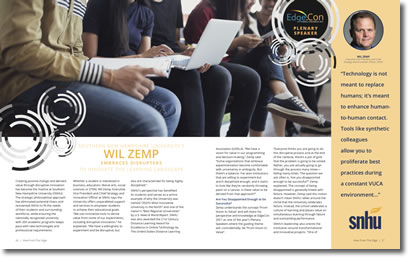Creating positive change and derived value through disruptive innovation has become the mantra at Southern New Hampshire University (SNHU). The strategic philosophical approach has eliminated potential chaos and reinvented SNHU to fit the needs of their students and surrounding workforce, while ensuring the nationally recognized university with 200 academic programs keeps pace with new technologies and professional requirements.
Whether a student is interested in business, education, liberal arts, social sciences or STEM, Wil Zemp, Executive Vice President and Chief Strategy and Innovation Officer at SNHU says the University offers unparalleled support and services to empower students to achieve their educational goals. “We use innovative tools to derive value from some of our experiments, including disruptive innovation,” he explained. “We have a willingness to experiment and be disruptive, but also are characterized for being highly disciplined.”
SNHU’s perspective has benefited its students and serves as a prime example of why the University was named “2020’s Most Innovative University in the North” and one of the nation’s “Best Regional Universities” by U.S. News & World Report. SNHU was also awarded the 21st Century Distance Learning Award for Excellence in Online Technology by The United States Distance Learning Association (USDLA). “We have a vision for value in our programming and decision-making,” Zemp said. “Some organizations that embrace experimentation become comfortable with uncertainty in ambiguity. But there’s a balance. I’ve seen institutions that are willing to experiment but aren’t disciplined enough, and it starts to look like they’re randomly throwing paint on a canvas. Is there value to be derived from that approach?”
Are You Disappointed Enough to be Successful?
Zemp understands the concept “From Vision to Value” and will share his perspective and knowledge at EdgeCon 2021 as one of the year’s Plenary Speakers where the guiding theme will, coincidentally, be “From Vision to Value”.
“Everyone thinks you are going to do this disruptive process and at the end of the rainbow, there’s a pot of gold that the problem is going to be solved. Rather, you are actually going to go through the process many times—failing many times. The question we ask often is, ‘Are you disappointed enough to be successful?’” Zemp explained. The concept of being disappointed is generally linked with failure. However, Zemp said this notion doesn’t mean SNHU rallies around the cliché that the University celebrates failure. Instead, the school celebrates a culture of learning and places value on simultaneous learning through failure and outstanding performance.
SNHU’s leadership also orients the institution around transformational and innovative projects. “One of the first steps you have to do is to clearly articulate the difference between productive and unproductive failures upfront, so productive failures yield value and are defined valuable information relative to the cause,” Zemp said. “A failure should be celebrated only if it’s relative to the cause because there’s very little tolerance in our culture for incompetence. Exploring risky ideas that ultimately fail is fine, but mediocre technical skills, sloppy thinking, bad work habits and poor management are not acceptable. Vision to value has to permeate everything including the things you’re disappointed in.”
“There is unyielding belief in human potential, and higher education is uniquely positioned to provide hope through the benefits of education. We don’t want people to lose faith in higher education’s role in being a trusted institution and our nation’s competitive edge.”
Wil Zemp
Executive Vice President and Chief Strategy and Innovation Officer, SNHU
Navigating the VUCA Landscape of Higher Education
Zemp has been working with the concept of VUCA – a volatile, uncertain, complex, and ambiguous environment – since his earliest days in the US Army. The concept is now embraced by innovative companies across industries, and it certainly applies in the current landscape of higher education. While many people are uncomfortable operating in a VUCA world, Zemp said that people who add a negative connotation to VUCA are likely revealing evidence of change fatigue.
“VUCA is a simply way to describe the constants in the environment. When you can accept the fact and orient on the philosophy that the world is VUCA – that ambiguity is a near guarantee – then the world becomes easier to deal with. When you think VUCA is temporal and only in pockets, then you’re orienting towards the world you want to be in versus the actual world you’re in, and this leads to unproductive failures and a waste of resources,” Zemp explained. “This resulting dynamic serves as the evidence behind a lot of frustration and ‘change fatigue’ in the workforce.”
In a VUCA environment, Zemp also cautions against innovating for innovation’s sake, as circumstances could create a frustrated workforce. Instead, the role of technology in a VUCA environment should be multi-layered: the strategic layer uses technology to enhance processes and solve problems. At the operational layer, technology provides ways to orient around being customer-obsessed (or, in Zemp’s case, learner-obsessed), solving problems and challenges for the customer. Through this process, the technical layer—or, as Zemp clarifies, the personal layer—can cut down on white noise and allow people to anticipate and solve problems. “Technology is not meant to replace humans; it’s meant to enhance human-to-human contact. Tools like synthetic colleagues allow you to proliferate best practices during a constant VUCA environment, as opposed to trying to solve VUCA as the problem,” Zemp said.
Limited budgets, for example, can become a disrupter in any industry and could add to the VUCA environment. However, a responsible organization will strategically invest in their resources so the institution is better aligned to match business innovation supply chains, the needs of their respective communities, and the talent needs of employers. Digital transformation plays a huge role in this process and higher education needs to make sure analog components are augmented throughout systems and technology. “Then, take any necessary human-to-human interactions and enhance them, making them more efficient and more meaningful,” Zemp added.
Finding the Best Technology Approach
There isn’t a one-size-fits-all approach in higher education, especially in regards to technology. Zemp said the best solution is to make incremental changes while adding or enhancing technology. Also, there are times where it’s best to use out-of-the-box customization as opposed to personalization for a technology solution. For those who lean risk averse, technology can provide the institution with tools for mitigating possible risks and trying new things. Higher education must also understand their students’ needs and ask about potential challenges. “Don’t stop there, but also ask what the employer demands for ‘uninvented’ jobs, and then ask how an institution can be the bridge between those two things,” Zemp said. “We want to live up to the obligation of trying to contribute towards making good citizens.”
SNHU has played a major role in growing and serving their students, using technological tools to create affordable higher education and maintain high graduation rates. The University continues to look at innovation and emerging technologies. “When frontline leaders become empowered with resources to make adjustments, a lot of positive things are going to happen,” he added.
Innovating for Gen Z and Beyond
Strategically thinking about the future will benefit any organization, but specifically institutions of higher education. In the next ten years, disrupters will appear and try to erode education. Schools will have to ride the disrupter curve and try and stay ahead. One big hurdle for education will be the introduction of Gen Z in 2030, bringing students with different needs than those currently enrolled. “These kids are basically eight or nine right now, and by 2030, these kids will be in or entering higher education. Their needs will be completely different,” Zemp said. “As an industry, we were caught off guard by Millennials and they made significant disruptions, but Gen Z has grown up in the digital spectrum complete with customization. If an institution can’t perform as a platform for them, students are going to go to another institution. We are already seeing the anecdotal evidence of a three-year-old walking up to a television to swipe it, with the resulting act knocking the television over because they’re trying to use the TV as an iPad. Imagine what the world will be like by the time they’re in college.”
Another disrupter Zemp foresees is the impact of emerging technologies. These tools like 5G will be present but not everywhere. “5G will have a tremendous impact, but the technology won’t be a normal expansion,” he explained. “The combination of change in your demand signal, change in your customer and how these emerging technologies will impact children growing up will be another disrupter.”
The constantly changing onslaught of devices and tools brought by students can also add to the VUCA environment because students expect their choice of technology to be fully supported. Zemp says the force of platform economics has created challenges, especially with personalization. Universities will have to navigate attention between customizing just enough to manage the craving for personalization. For instance, if Zemp were to sit down with a friend between the ages of 45 and 50, the friend might think his iPhone was fully customized. “Studies suggest this notion probably isn’t fully accurate because there are varying levels of what it means to fully customize – and optimize – one’s device,” he said. “Gen Z users use 98% of all functions on any device they have, and it is unreal what they can do right now compared to all prior generations.” Going forward, Zemp said by 2030, these students are going to expect complete personalization. “The extension of whatever platform they want to be on will need to be personalized,” he added. “Everything centers on personalization.”
This emerging dynamic is an opportunity for higher education to seize the moment. “Take on the benefits and harness them with emerging technologies that are coming online,” he said. “There is unyielding belief in human potential, and higher education is uniquely positioned to provide hope through the benefits of education. We don’t want people to lose faith in higher education’s role in being a trusted institution and our nation’s competitive edge.” While “disrupters” have the potential to create unruly chaos and possible “failure,” the organizations that strategically plan for disruptive innovation will easily become the game-changers in higher education.
Confirm your spot at EdgeCon 2021 by visiting NJEdge.net/edgecon2021 to see Wil Zemp take the virtual stage for a future-forward Plenary Session.



